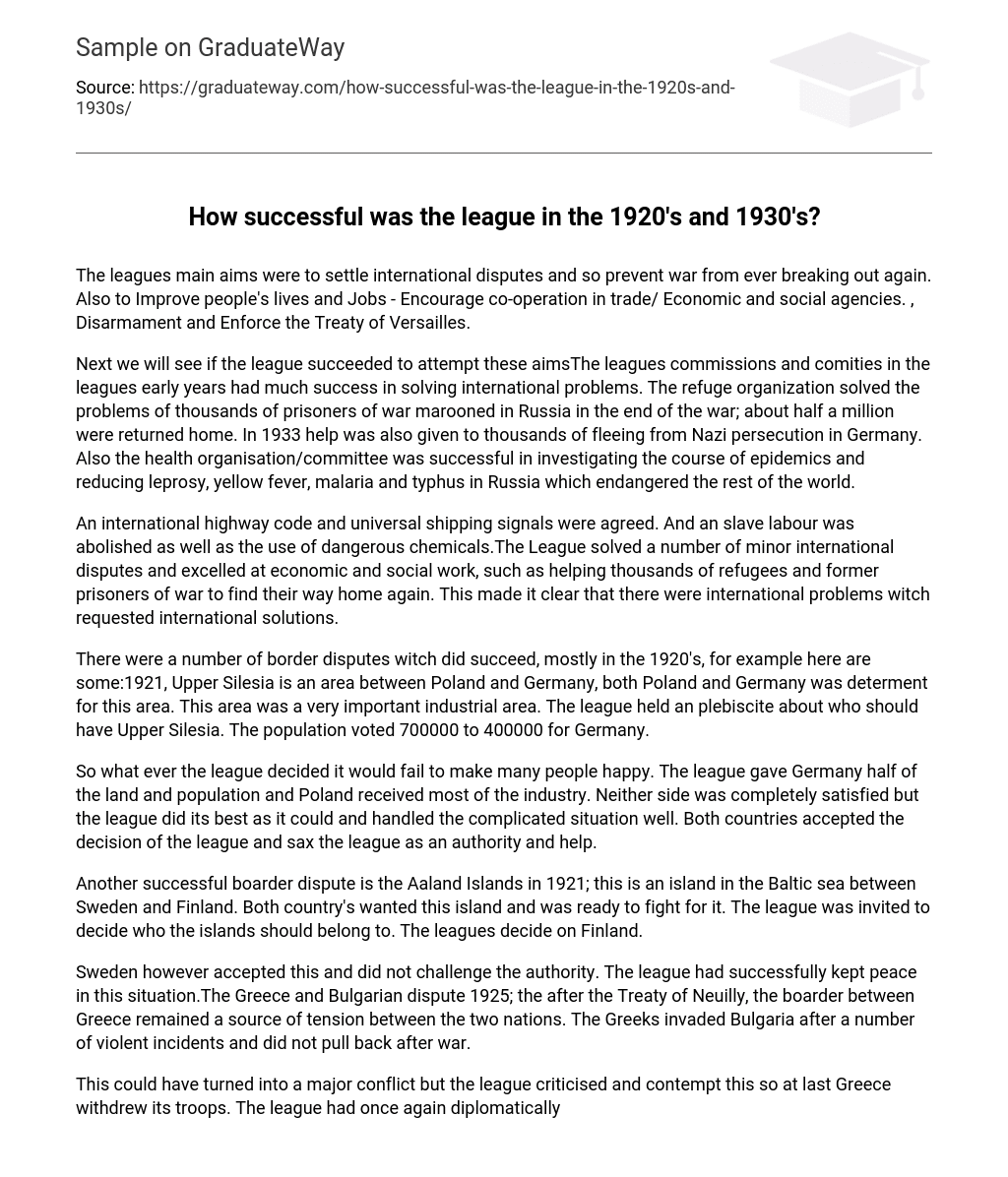The main objectives of the League were to settle international disputes and prevent future wars. Additionally, it aimed to enhance people’s lives and employment opportunities by encouraging cooperation in trade, economic and social organizations. The League also focused on disarmament and the enforcement of the Treaty of Versailles.
Next, we will see if the league succeeded in attempting these aims. The league’s commissions and committees in its early years achieved much success in solving international problems. The refugee organization resolved the issues of numerous prisoners of war stranded in Russia at the end of the war, resulting in approximately half a million being repatriated. In 1933, assistance was also provided to thousands fleeing from Nazi persecution in Germany. Additionally, the health organization/committee effectively investigated the causes of epidemics and successfully reduced cases of leprosy, yellow fever, malaria, and typhus in Russia, thus safeguarding the rest of the world.
Agreements were made for an international highway code and universal shipping signals, while also abolishing slave labor and the use of dangerous chemicals. The League successfully resolved minor international disputes and excelled in economic and social work, including assisting refugees and former prisoners of war in returning home. These accomplishments highlighted the need for international solutions to address global problems.
There were several border disputes that took place, mostly in the 1920’s. One such dispute, occurring in 1921, revolved around Upper Silesia – an area located between Poland and Germany. Both countries were determined to claim this strategically significant industrial region. To determine the rightful owner of Upper Silesia, a plebiscite was held by the League of Nations. The population voted 700,000 in favor of Germany and 400,000 for Poland.
Regardless of the league’s decision, it failed to satisfy many individuals. Germany was granted half of the land and population, while Poland acquired the majority of the industry. While neither side was entirely content, the league managed the complex situation to the best of its ability. Both nations accepted the league’s decision and acknowledged it as an authoritative and helpful force.
Another triumph in resolving a territorial conflict is the Aaland Islands dispute of 1921, which involves an island situated in the Baltic Sea. The island was coveted by both Sweden and Finland, and both nations were prepared to engage in battle over it. The League of Nations was called upon to make a determination on which country the islands should be awarded to. Ultimately, the League of Nations ruled in favor of Finland.
Sweden acquiesced to this and did not question the authority, thus maintaining peace. The conflict between Greece and Bulgaria in 1925 persisted even after the Treaty of Neuilly, as the border remained a source of tension for both nations. In response to several violent incidents, Greece invaded Bulgaria and did not withdraw following the end of the war.
Despite the potential for significant conflict, the league effectively managed to handle this situation through criticism and contempt. Consequently, Greece eventually withdrew its troops, leading to another successful diplomatic resolution by the league. Certain countries demonstrated their acceptance of the league’s authority and decision-making. However, there were also countries whose leaders did not cooperate, such as the Disarmament Commission. This commission failed to make any progress in convincing member states to reduce armaments, despite their previous commitment upon joining the League of Nations.
The political disputes in Vilna in 1920 were a consequence of the new borders established in Europe after the war. The region of Vilna, which became part of Lithuania, became a source of contention between Lithuania and Poland due to its predominantly Polish population. Tensions escalated when Polish forces refused to withdraw from Vilna after a war with Russia. As a result, the community sought help from the League of Nations.
However, the league was unable to take any action against Poland because they lacked an army. Additionally, the individual league members were reluctant to provide their own forces for a cause that would not benefit them directly. Diplomatic attempts to resolve the dispute proved futile, and in 1923, Poland captured Vilna. This passive response by the league conveyed a clear message globally and established a precedent for the future. In another incident in 1923, five Italians who were employed by the league in Greece lost their lives in Corfu.
Mussolini demanded compensation from the Greek government but when they refused, he attacked and occupied the island of Corfu. This presented an ideal opportunity for the league to enforce their policy as Italy was a prominent and powerful member.
Despite the powers in the Security Council refusing to condemn it, they instead exerted pressure on Greece to comply with Mussolini’s demands. Ultimately, Greece publicly apologized and provided compensation. This entire situation proved to be a disaster, as it showcased to the world that the League was ineffective in upholding its founding principles when facing aggression from powerful leaders or nations. While the idea of the League was initially an excellent and noble one proposed by pessimist Wilson, it was doomed from the start due to the lack of contribution from the United States.
When Britain and France had the opportunity to step in and address the void left by America’s absence, they failed to fully commit to the League of Nations and instead prioritized their own nations and interests. As a result, the league was unable to effectively respond to aggressive actions by powerful leaders due to its lack of an army, which all members were supposed to contribute to. Ultimately, the league became more of a failure than a success in achieving its main goals.





